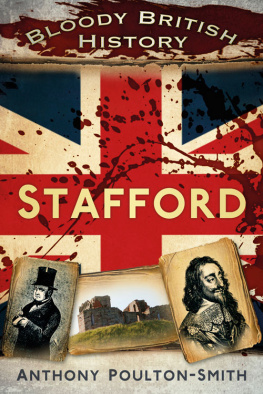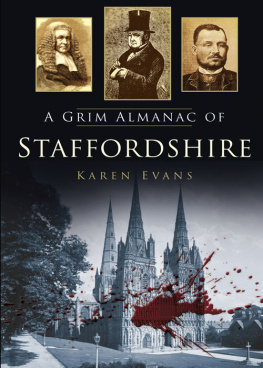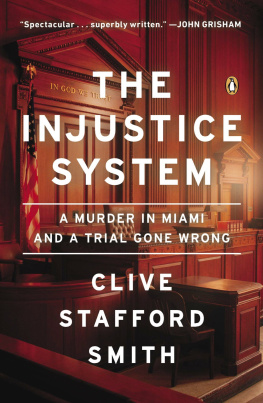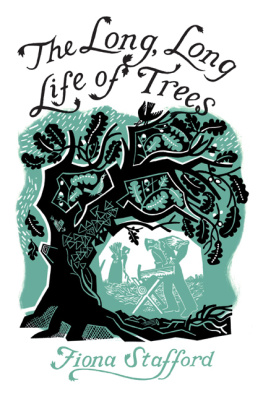
CONTENTS
99 BC |
AD 99 |
AD 913 |
AD 1069 |
AD 1399 |
Richard II led in chains through Stafford |
AD 1560 |
The Horrors of Staffords Unsanitary Streets |
AD 1625 |
The Most Bizarre Map in Staffords History Revealed |
AD 1643 |
AD 1646 |
AD 1649 |
John Bradshaw and the Death of Charles I |
AD 1680 |
The Terrible Story of Titus Oates |
AD 1742 |
AD 1772 |
Life and Death in Stafford General Infirmary |
AD 1784 |
AD 1795 |
AD 1833 |
AD 1836 |
The Strange Case of Mary Kearnes |
AD 1838 |
AD 1840 |
The Tragical Case of Christina Collins |
AD 1841 |
or, Who Killed Martha Keeling? |
AD 1842 |
AD 1855 |
Three of Staffords Weirdest Deaths Revealed |
AD 1856 |
William Palmer |
AD 1857 |
AD 1860 |
AD 1870 |
AD 1887 |
AD 1889 |
AD 1940 |
99 BC
T HE PROBLEM WITH telling the story of Iron Age Stafford is the lack of a permanent settlement. As the name given to the era tells us, this was a time when bronze was no longer the only metal produced by smelting now the much stronger iron was available. The changes in everyday life could be compared to the advancements in the twentieth century, which saw steam and gas lighting become virtually obsolete as electrical power was harnessed.
That there is no evidence of Celtic culture in the county, save for the Romano-British settlements of Letocetum near Lichfield in the south and in the north Rocester and Chesterton, is down to the lack of local materials for the production of iron during this period.
The local Celtic tribe were the Cornovii, their territory extending over Cheshire, Shropshire and across what is now the border into Wales. While they had no coinage they were certainly wealthy enough. Fundamentally an agrarian economy, they were renowned cattle breeders, and also produced vast amounts of salt from their lands in Cheshire. Records from the Greeks and Romans show they had a network of paved roads along which they distributed the salt.

Stafford is an Old English place name there was no history of Stafford in 99 BC . The name did not exist until AD 913, when the first written record of Staefford is found.

The idea these were naked, painted savages is completely wrong. Read Roman writings and it is obvious that they considered the natives vain and much concerned with appearance and personal hygiene. The Cornovii excelled in weaving and dyed their cloth in the brightest of colours. Women had long hair, plaited in two lengths which often almost reached their knees. Their tribal name is thought to describe the people of the horned one, a reference to the image of their chief god. Although similarly-named tribes have been located in Caithness and Cornwall, there was no actual connection between the three tribes, which were as far removed as it is possible for three groups to be on the British mainland.
Little archaeological evidence has been discovered prior to the Roman occupation. For some time this was thought to indicate a lack of possessions and thus a lack of wealth. However, throughout recorded history Staffordshire has been a county with low population density. The population was further reduced by Conquest: at the time of the Domesday Survey the valuation of the parishes clearly reflect the brutal suppression of William the Conqueror.
Perhaps a lack of surviving evidence from the Celtic era is not so much because it was a period of constant conflict but quite the reverse. Indeed the few archaeological records found in the Stafford area are a result of battles. Skeletal remains showing injuries sustained in battle have been unearthed, their identity shown by the clothing and artefacts found alongside.
Most conflicts between rival tribes were ritualised. Champions and leaders fought duels after boasting of the personal achievements of their ancestors. It was the failure of these rituals which led to a full-blooded battle, and it is the remains of such we find in Stafford.
Before any actual fighting broke out the Celts would sound war horns, ride around in their chariots, and clatter weapons against wooden shields to add to the din. As the cacophony peaked, and with adrenalin flowing freely, the combatants charged and, shortly before clashing hand to hand, launched a light javelin at the foe. This tactic was primarily to distract and slow the charge rather than maim the enemy. It was in personal combat these warriors tested their prowess.
The principal weapon was the battle-axe. Doubtless the more experienced warrior had his own particular tricks of the trade but, in general terms, the winner was inevitably the one who bludgeoned his opponent first and/or hardest. Wooden shields would not offer much in the way of protection and were only really of use in deflecting the blow. A short handle made it easier to wield, especially in tight quarters.
Examining the skeletons shows most blows were delivered with a downward movement and principally to the area of the neck and ribcage. Other axe marks are found to the arms and legs: these were designed to impair movement and produce an advantage rather than to kill. A successful hit at the neck or shoulder would cleave the opponent in two, with death inevitable and hopefully mercifully quick. We also find evidence of ribs broken by feet as the victor braced himself against his victim in order to retrieve the blade buried so deeply into the torso.
During this period the spiritual side of life was, sources lead us to believe, primarily influenced by the druids, though virtually nothing is known of their rites and practices at the time. Virtually everything attributed to this period was written by the Romans much later: contemporary Greek reports speak of druids as priests who dabbled in rites more associated with magic but admit little is definitely known about them. Named Celtic deities are generally those worshipped by the Gauls in France, most of which were also common to the pagan Roman religion. It was when the Romans came to Britannia that the druids were hunted down and eventually forced to retreat to the island of Anglesey off the north coast of Wales. Legends of their defence, and the horrific slaughter which ensued, are predominantly based on the reports of Tacitus, the authenticity of which is questionable.

These Celtic peoples could never have been a part of the Roman Empire, for the first Roman emperor was not in power until 27 BC . From the founding of Rome in 753 BC until 509 BC Rome was a kingdom. In between, which includes 99 BC , it was the Roman Republic.

Next page








